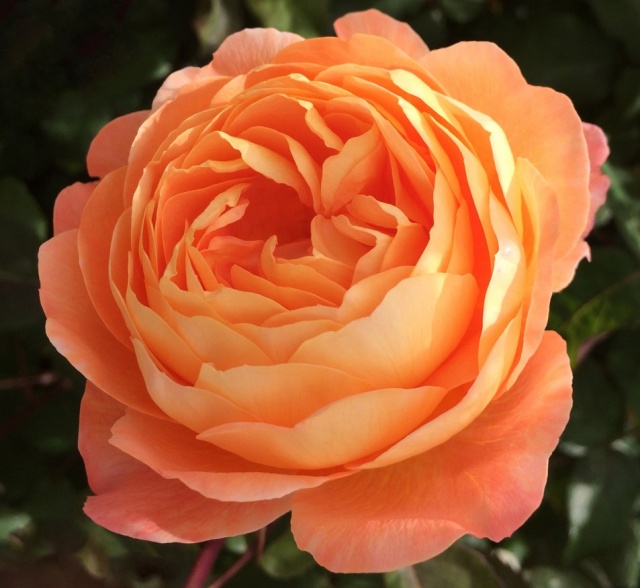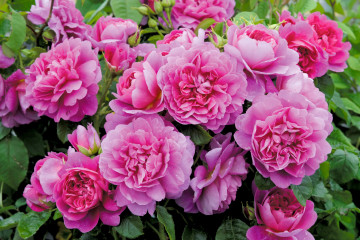Rose Lady Emma Hamilton (Lady Emma Hamilton) - variety description
Content:
Rose Lady Emma Hamilton is a unique specimen created by David Austin and belongs to the group of boles. This variety combines all the best features of an ornamental plant: optimal appearance of the bush, positive properties of old varieties, long flowering period and good disease resistance.
Brief description, characteristic
Lady Emma Hamilton rose was bred over 10 years ago. Now she has gained great popularity because of her beauty and original scent, as well as unpretentious care. The rose was named after the beloved woman of Admiral Nelson. Several years after the Lady Emma Hamilton variety was introduced, it was introduced to America, where it sparked the interest of flower growers and won many awards for its wonderful scent.
The bushes reach a height of 100-150 cm with an incredible color of flowers, miniature, branched, with straight stems. By its appearance, the rose resembles a large blooming ball. Leaves of a bronze shade well set off large flowers, later they acquire a rich green color.
The unblown buds are characterized by a burgundy color interspersed with orange. The inner part of the petals of the culture has an orange hue. The outer is yellow or pink in color. There is a pronounced fruity aroma, where the aromas of grapes, orange and pear are mixed.
Advantages and disadvantages of the variety
This rose has more pluses than minuses. Pros:
- long and strong flowering, with a unique scent;
- undemanding care;
- cold resistance;
- disease resistance.
There is only one drawback - this is the too high cost of planting material.
Use in landscape design
There are many options for using roses to decorate a plot. It will look good against the background of a gazebo, benches in the garden, along the buildings. This plant looks good in a flower bed, because it has a long flowering period, and the buds retain an attractive and neat appearance for a long time.
The plant is used in landscape design to decorate mixborders. In addition, this culture is planted along the paths in greenhouses and squares. Roses are well suited for zoning areas, for alpine slides and greenhouses. The rose will look organic in any garden.
Growing a flower, how to plant it in open ground
In the northern part of Russia, rose planting begins at the end of April-May. You can plant a rose in the fall, so that the rooting of the culture has time to occur before the first frost. Landing slope should be up to 25 degrees in relation to the support.
Location selection
In the southern regions, the plant is placed so that after lunch a light partial shade is created. This is done to prevent leaf burns.
Before planting plants, you need to carefully choose a location. The rose prefers places with good air circulation, this will protect it from fungal infections. It is unacceptable to grow this variety in lowlands, where cool air masses stagnate, this will cause frequent illnesses.
How to prepare the soil and flower for planting
Before planting a rose, you must act in the following sequence:
- Spread out the root system and inspect it for damage. If such are identified, treat these places with medicinal preparations.
- Trim dry and very long roots. This makes it possible for the culture to grow new roots in the future, and to improve the absorption of nutrients for the remaining roots.
- Inspect the plant for dry shoots and branches, remove if any.
- Soak the root system in water or a growth-promoting substance. So the plant will receive the necessary moisture.
In what form is the landing
Roses are planted using cuttings that are taken from healthy and vigorous plants and take root. The second common method is with seedlings.
Planting procedure step by step
First you need to dig a hole half a meter deep. Put gravel or crushed stone at the bottom, then add a layer of compost or organic matter. Pour a layer of soil with a thickness of 100 mm on top.
After the rose Emma is planted, it needs to be watered at the root. If in the process the earth settles a little, it needs to be filled up to normal.
Plant care
A luxurious Englishwoman does not require any special conditions of detention, but the state of her appearance is highly dependent on taking care of her.
Watering rules and humidity
Water the plant often and abundantly, but avoid stagnation of water, as this affects the condition of the root system. It should be watered in the morning and evening with warm, settled water.
Top dressing and soil quality
In the spring, it is necessary to apply organic and nitrogen fertilizers as top dressing. In the summer, potassium-phosphorus. In the fall, no feeding is done.
Pruning
An important step in caring for a rose is pruning. The bushes should be freed from old, damaged and diseased shoots. The branches need to be pruned one third to aid in crown formation. After the plant has bloomed, you need to cut off all dry buds and start preparing the wintering of the plant.
Wintering features
Since this variety of roses is resistant to negative temperatures, it does not need to be covered carefully. It is enough just to do mulching in the hole, and the rest will be covered with snow, which will protect from frost. But in order to reduce the risks, if the winter is not snowy, it is better to cover the bush with a non-woven material.
Blooming rose
A rose will decorate any garden with its flowers. Caring for her during flowering is quite simple.
A period of activity and rest
The active period for the rose is from April to September. During this period, constant care is provided, it is aimed at supporting the active growth of plants.
The dormant period starts from September to March; care is required here, which slows down the growing season. This is necessary to prepare rose bushes for frost.Watering at the beginning of autumn must be significantly reduced, and from the beginning of October, stop altogether. If the autumn is very rainy, then in order to prevent root decay, you need to make grooves along which the water leaves.
Care during and after flowering
July is the month of strong blooming of roses. At this time, you must not forget to remove the buds that have had time to bloom. If this is not done, then seeds will begin to form, on which the plant will put all its strength, and this will slow down the secondary flowering.
Blooming roses are not fed, so as not to shorten the flowering period. If the weather is hot, then you need to water the bushes abundantly and often.
What to do if it does not bloom, possible reasons
Quite often it happens that a rose does not bloom for a long time or does not bloom at all. There are many reasons for this.
If the rose does not bloom in the year of planting, then this is quite normal, because this is due to the stage of development of the seedling. Much also depends on the correctness of the actions of the grower. For example, a wrong landing site could be a problem. If a rose bred by Austin grows along fences and in the shade of shrubs and trees, it will not bloom.
The lack of flowers can also be affected by improper pruning or improperly created conditions of detention. In such cases, you should simply eliminate the source of the problem.
Reproduction
Most people think that planting and replanting a rose is better in spring, but this is not the case. It is better to replant it in the summer, especially in those areas where the winter period is characterized by a mild climate. It also allows for earlier flowering.
How does the multiplication of a rose
The most popular way to propagate a rose is by cuttings. To carry out this procedure, you must adhere to certain rules.
To begin with, after the most optimal stem has been chosen, you need to cut it off correctly. This affects how the flower will develop and its resistance to weather and cold. The cut must be done at a distance of 0.15 cm from the kidney.
There should be at least three buds between the upper and lower slices. You need to make a cut with sharp objects so as not to injure the plant. The leaves are removed from the bottom of the cutting and shortened from above. Dip the lower cut in potassium permanganate. During the day, the cutting must be kept in a solution that promotes root formation.
Now it is necessary for the cutting to take root, for this it should be kept in a greenhouse for a crescent. During this period, the future culture should receive the right amount of heat and light. The soil should be slightly damp, the main thing is not to overdo it, so as not to cause rotting of the roots.
When planting in unprotected soil, it is important to calculate the correct depth. The best will be 10-15 mm. At greater depths, rooting will proceed at a slow pace.
Diseases, pests and ways to control them
This rose variety is disease resistant. This positive quality is weakened by too thick planting of the bushes. A dense planting makes it difficult to loosen the soil and leads to insufficient watering. Frequent rains in summer cause the roses to be attacked by powdery mildew.
The variety of roses bred by David Austin will adorn any garden, greenhouse, gallery. In addition, they are planted on balconies, in flowerpots and containers placed on open verandas.





















